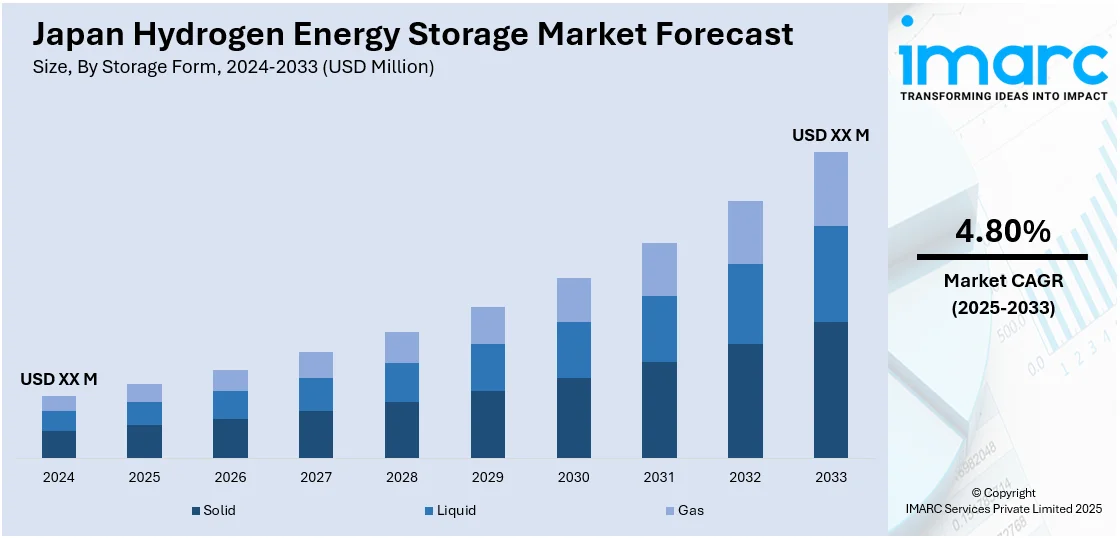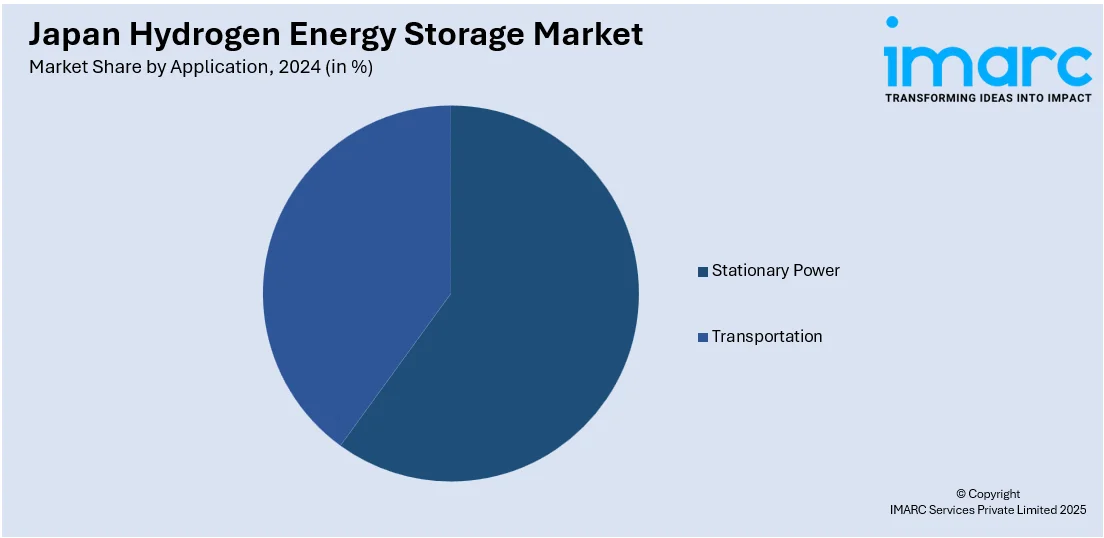
Japan Hydrogen Energy Storage Market Size, Share, Trends and Forecast by Storage Form, Technology, Application, End User, and Region, 2025-2033
Japan Hydrogen Energy Storage Market Overview:
The Japan hydrogen energy storage market size is projected to exhibit a growth rate (CAGR) of 4.80% during 2025-2033. The market is driven by the strong government policies promoting carbon neutrality, increased investment in renewable energy integration, and energy security concerns. The country is advancing pilot projects in green hydrogen production and storage, particularly through collaborations with the private sector and regional energy suppliers. Additionally, the growing focus on smart grid development and mobility-based hydrogen applications is an important factor expanding the Japan hydrogen energy storage market share.
|
Report Attribute
|
Key Statistics
|
|---|---|
|
Base Year
|
2024 |
|
Forecast Years
|
2025-2033
|
|
Historical Years
|
2019-2024
|
| Market Growth Rate 2025-2033 | 4.80% |
Japan Hydrogen Energy Storage Market Trends:
National Hydrogen Strategy and Policy Support
The market is significantly shaped by the country's national strategy targeting carbon neutrality by 2050, which emphasizes hydrogen as a cornerstone of its future energy mix. The Strategic Roadmap for Hydrogen and Fuel Cells, revised in 2023, outlines clear goals for expanding hydrogen use in industry. As per industry reports, Japan's updated plan aims to produce 15 Trillion Yen (about USD 96.77 Billion) in public and private sector investment in hydrogen over the next 15 years, with the goal of increasing hydrogen use sixfold by 2040. Moreover, government-backed initiatives include subsidies for storage technologies, public-private partnerships to deploy hydrogen storage systems, and regulatory support for grid integration. Also, the Ministry of Economy, Trade and Industry (METI) has established frameworks to commercialize hydrogen storage by promoting advanced materials research and supporting pilot demonstrations of high-capacity systems, including liquid hydrogen and metal hydride storage units. In addition to this, Japan’s Basic Hydrogen Strategy focuses on building international supply chains, indirectly bolstering storage development by ensuring consistent hydrogen availability. These policy mechanisms provide long-term certainty to investors and manufacturers, accelerating technology maturation and infrastructure deployment across decentralized and centralized storage segments.

Advancements in Hydrogen Storage Technologies
Continual technological advancements are driving Japan hydrogen energy storage market growth, with active contributions from shipbuilders, steel manufacturers, and energy technology developers. On March 28, 2025, Tsuneishi Shipbuilding Co., Ltd. unveiled Japan’s first hydrogen-powered tugboat at its Fukuyama facility in Hiroshima. The vessel integrates a hydrogen dual-fuel internal combustion engine and a high-pressure hydrogen gas storage system, representing a milestone in maritime decarbonization. It also utilizes "JGreeX" green steel from JFE Steel Corporation, significantly cutting embedded CO₂ emissions and aligning with the country’s carbon-neutral shipping objectives. This innovation complements broader national efforts in storage technology. Apart from this, Japanese stakeholders are developing high-pressure gas tanks, cryogenic liquid hydrogen storage systems, and solid-state solutions such as metal hydrides and chemical carriers. Emerging storage formats include ammonia and liquid organic hydrogen carriers (LOHCs), which allow for stable, dense, and transportable storage with minimal pressure requirements. Moreover, major companies in the market are progressing with commercial-scale demonstrations. Also, efforts in materials engineering and smart monitoring are enhancing storage safety, thermal stability, and scalability, reinforcing Japan’s ability to manage hydrogen across diverse industrial and energy applications.
Japan Hydrogen Energy Storage Market Segmentation:
IMARC Group provides an analysis of the key trends in each segment of the market, along with forecasts at the country and regional levels for 2025-2033. Our report has categorized the market based on storage form, technology, application, and end user.
Storage Form Insights:
- Solid
- Liquid
- Gas
The report has provided a detailed breakup and analysis of the market based on the storage form. This includes solid, liquid, and gas.
Technology Insights:
- Compression
- Liquefaction
- Material Based
A detailed breakup and analysis of the market based on the technology have also been provided in the report. This includes compression, liquefaction, and material based.
Application Insights:

- Stationary Power
- Transportation
The report has provided a detailed breakup and analysis of the market based on the application. This includes stationary power and transportation.
End User Insights:
- Utilities
- Industrial
- Commercial
A detailed breakup and analysis of the market based on the end user have also been provided in the report. This includes utilities, industrial, and commercial.
Regional Insights:
- Kanto Region
- Kansai/Kinki Region
- Central/Chubu Region
- Kyushu-Okinawa Region
- Tohoku Region
- Chugoku Region
- Hokkaido Region
- Shikoku Region
The report has also provided a comprehensive analysis of all the major regional markets, which include Kanto Region, Kansai/Kinki Region, Central/Chubu Region, Kyushu-Okinawa Region, Tohoku Region, Chugoku Region, Hokkaido Region, and Shikoku Region.
Competitive Landscape:
The market research report has also provided a comprehensive analysis of the competitive landscape. Competitive analysis such as market structure, key player positioning, top winning strategies, competitive dashboard, and company evaluation quadrant has been covered in the report. Also, detailed profiles of all major companies have been provided.
Japan Hydrogen Energy Storage Market News:
- On March 12, 2025, Japan initiated its ¥5.7 Billion (about USD 38 Million) tender under the national hydrogen hubs programme, aiming to subsidize shared infrastructure such as pipelines and storage facilities to support multiple companies. This tender marks a significant step in Japan's broader strategy to establish eight to ten hydrogen and ammonia hubs over the next decade, focusing on both metropolitan and regional areas. The initiative aligns with Japan's commitment to decarbonization and energy security.
Japan Hydrogen Energy Storage Market Report Coverage:
| Report Features | Details |
|---|---|
| Base Year of the Analysis | 2024 |
| Historical Period | 2019-2024 |
| Forecast Period | 2025-2033 |
| Units | Million USD |
| Scope of the Report |
Exploration of Historical Trends and Market Outlook, Industry Catalysts and Challenges, Segment-Wise Historical and Future Market Assessment:
|
| Storage Forms Covered | Solid, Liquid, Gas |
| Technologies Covered | Compression, Liquefaction, Material Based |
| Applications Covered | Stationary Power, Transportation |
| End Users Covered | Utilities, Industrial, Commercial |
| Regions Covered | Kanto Region, Kansai/Kinki Region, Central/Chubu Region, Kyushu-Okinawa Region, Tohoku Region, Chugoku Region, Hokkaido Region, Shikoku Region |
| Customization Scope | 10% Free Customization |
| Post-Sale Analyst Support | 10-12 Weeks |
| Delivery Format | PDF and Excel through Email (We can also provide the editable version of the report in PPT/Word format on special request) |
Key Questions Answered in This Report:
- How has the Japan hydrogen energy storage market performed so far and how will it perform in the coming years?
- What is the breakup of the Japan hydrogen energy storage market on the basis of storage form?
- What is the breakup of the Japan hydrogen energy storage market on the basis of technology?
- What is the breakup of the Japan hydrogen energy storage market on the basis of application?
- What is the breakup of the Japan hydrogen energy storage market on the basis of end user?
- What is the breakup of the Japan hydrogen energy storage market on the basis of region?
- What are the various stages in the value chain of the Japan hydrogen energy storage market?
- What are the key driving factors and challenges in the Japan hydrogen energy storage market?
- What is the structure of the Japan hydrogen energy storage market and who are the key players?
- What is the degree of competition in the Japan hydrogen energy storage market?
Key Benefits for Stakeholders:
- IMARC’s industry report offers a comprehensive quantitative analysis of various market segments, historical and current market trends, market forecasts, and dynamics of the Japan hydrogen energy storage market from 2019-2033.
- The research report provides the latest information on the market drivers, challenges, and opportunities in the Japan hydrogen energy storage market.
- Porter's five forces analysis assist stakeholders in assessing the impact of new entrants, competitive rivalry, supplier power, buyer power, and the threat of substitution. It helps stakeholders to analyze the level of competition within the Japan hydrogen energy storage industry and its attractiveness.
- Competitive landscape allows stakeholders to understand their competitive environment and provides an insight into the current positions of key players in the market.
Need more help?
- Speak to our experienced analysts for insights on the current market scenarios.
- Include additional segments and countries to customize the report as per your requirement.
- Gain an unparalleled competitive advantage in your domain by understanding how to utilize the report and positively impacting your operations and revenue.
- For further assistance, please connect with our analysts.
 Request Customization
Request Customization
 Speak to an Analyst
Speak to an Analyst
 Request Brochure
Request Brochure
 Inquire Before Buying
Inquire Before Buying




.webp)




.webp)












